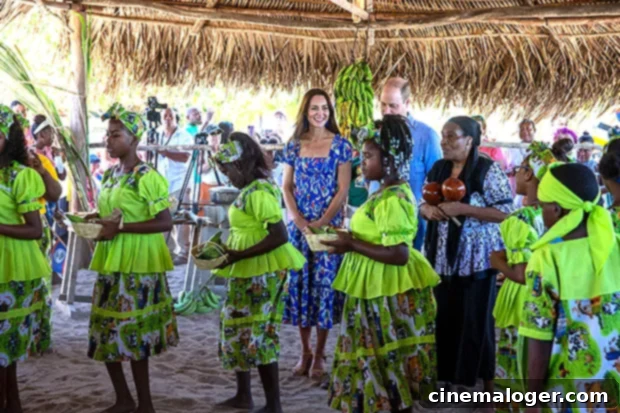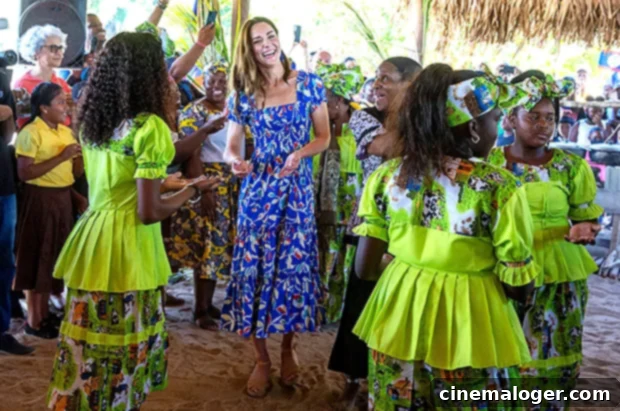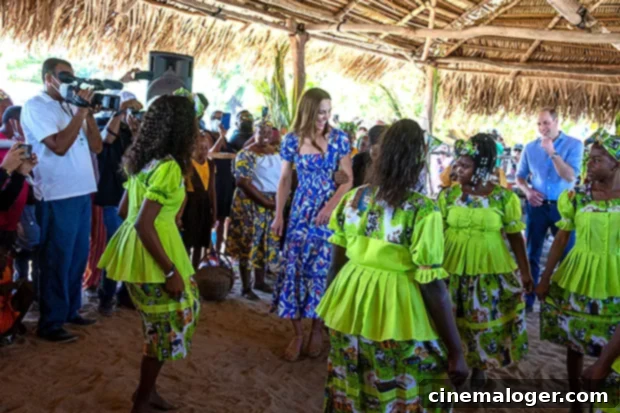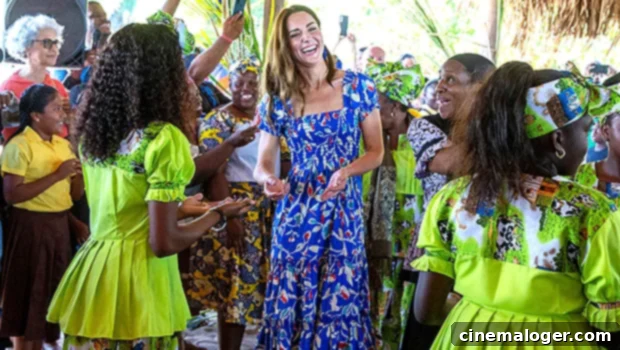Prince William and Kate Middleton’s Viral Dance in Belize: Caribbean Tour Highlights and Royal Diplomacy
In a delightful display of cultural engagement and unexpected spontaneity, Prince William, 39, and Kate Middleton, 40, captured global attention with their impressive dance moves during their highly anticipated royal tour of the Caribbean. The Duke and Duchess of Cambridge embarked on a significant visit to the village of Hopkins in Belize on Sunday, March 20, where they were warmly welcomed by the vibrant Garifuna community. This particular stop on their tour quickly became a viral sensation, showcasing a rarely seen, relaxed, and joyful side of the royal couple. Prince William, dressed impeccably in a blue button-down shirt and matching blue pants – a subtle nod to Belize’s national color – enthusiastically joined in the traditional dancing with a local woman, demonstrating a willingness to fully immerse himself in the local culture.
The atmosphere in Hopkins was electric as the royal couple stepped onto the dance floor. Kate Middleton, resplendent in a stunning blue floral dress, radiated elegance and charm as she playfully danced towards her husband amidst a cheering crowd of locals and an eager press corps. This moment was particularly striking given the royal family’s typically reserved public demeanor. William and Kate are known for their professionalism and often maintain a certain formality in their official engagements, rarely showing overt affection in public settings. Therefore, witnessing them let their guard down, laugh freely, and genuinely enjoy performing their royal duties through the universal language of dance was a refreshing and memorable experience for everyone present and those watching worldwide. This candid interaction highlighted their approachability and commitment to connecting with the communities they visit, moving beyond ceremonial greetings to truly participate in the local traditions.
The Duke and Duchess of Cambridge, Prince William and Kate, share a dance with Garifuna dancers during a cultural presentation in Hopkins pic.twitter.com/7XTyGnHEnn
— Breaking Belize News (@belizemedia) March 20, 2022

Embracing the Garifuna Culture: Royal Dance Partners Speak Out
The Garifuna community, descendants of West African, Arawak, and Carib people, is renowned for its rich cultural heritage, particularly its music and dance. The particular dance performed by the Duke and Duchess was the “punta,” a lively and energetic dance form that is central to Garifuna celebrations. This cultural exchange was not only visually captivating but also deeply meaningful, fostering a genuine connection between the royals and the local population.
Laura Cacho, the local woman who had the distinct honor of dancing with Prince William, shared her enthusiastic praise for the royal couple in an interview with People. Her words painted a picture of a couple who were not just fulfilling an obligation but genuinely enjoying the moment. “They are an amazing couple and we would love them to come any time with their children Charlotte, George and Louis,” she expressed, highlighting the warmth and hospitality extended to the Duke and Duchess. Cacho was particularly impressed by their natural rhythm and eagerness to participate. “They really know how to dance. They took the culture from me and I didn’t need to teach them. They’re so good at it. They were excellent,” Laura added, emphasizing how easily William adapted to the unfamiliar dance steps, a testament to his good sportsmanship and open-mindedness. This genuine appreciation from a local community member underscored the success of this particular royal engagement in fostering goodwill and cultural understanding.

Adding to the heartwarming accounts, Cynthia Ellis-Topsy, the esteemed ambassador for the Garifuna nation, shared her perspective on encouraging the royal couple to join the dance. She recounted how she personally invited William and Kate to try the local punta, recognizing the importance of such gestures for cultural diplomacy. “I said, ‘I’ll hold your hand and we will do it together.’ He did dance and it was beautiful,” she told People, illustrating William’s immediate enthusiasm. While Kate initially seemed “a bit nervous,” Ellis-Topsy noted her grace and appreciation, especially for the children present. “She certainly appreciated the children. We need to change the mindset and that’s best through the children,” the ambassador reflected, emphasizing the long-term impact of royal visits on inspiring younger generations and fostering cultural pride. These interactions demonstrate the profound impact that such personal engagements can have, going beyond mere photo opportunities to create lasting memories and strengthen community bonds. The willingness of the Duke and Duchess to step out of their comfort zone and embrace local customs played a pivotal role in making their Belize visit a resounding success, particularly from a cultural standpoint.

The Broader Context: Diplomacy, Heritage, and Modern Challenges in the Caribbean Royal Tour
While moments of joy and cultural immersion dominated headlines, the Duke and Duchess of Cambridge’s visit to the Caribbean carried significant geopolitical weight and faced its share of complexities. Royal tours to Commonwealth nations in the Caribbean have long been a British tradition, famously carried out by William’s late mother, Princess Diana. These tours historically serve to reinforce ties between the UK monarchy and its former colonies, now independent nations within the Commonwealth. However, in the modern era, as countries like Barbados seek to transition to full independence from the UK as their own republics – a move they successfully completed in late 2021 – some observers view such tours as delicate diplomatic missions. According to reports from The Guardian, a segment of public opinion perceives these visits as thinly-veiled attempts to garner support for the monarchy and assure stability within a shifting global landscape. The tour’s timing coincided with growing calls for reparations for historical injustices related to slavery and increased scrutiny over the monarchy’s role in modern Commonwealth affairs.
Beyond the broader political currents, specific local grievances also emerged during the Belize leg of the royal tour. Residents of the Toledo district in Belize voiced strong objections concerning land disputes and their dissatisfaction with a charity supported by Prince William, Flora and Fauna International. These protests highlighted the intricate balance the royals must strike between promoting goodwill and navigating deeply rooted local political and social issues. The Duke and Duchess found themselves at the forefront of evolving discussions about post-colonial relationships and the future of the Commonwealth, demonstrating the multifaceted nature of modern royal duties.
In response to these sensitivities, Kate and William had to make a swift adjustment to their itinerary. An initially planned visit to a cacao farm in the region was canceled in light of the local upset and protests. This decision underscored the palace’s awareness of the delicate political environment and their commitment to respecting local sentiments, even if it meant altering long-standing plans. Despite this initial hurdle, the royal couple resumed their duties with characteristic grace and professionalism. They arrived at Belize on March 19 with big smiles on their faces as they exited the airplane, signaling their dedication to the tour’s objectives. Furthermore, their thoughtful choice to both wear blue upon arrival was a deliberate and visually impactful gesture of respect towards Belizeans, acknowledging the country’s colors and national identity. This sartorial diplomacy, coupled with their willingness to engage culturally, played a crucial role in mitigating tensions and reaffirming their commitment to fostering positive relations with the people of Belize.
Beyond the Dance Floor: The Impact of Royal Engagement
The viral dance moves of Prince William and Kate Middleton in Belize were more than just entertaining; they served as a powerful symbol of the evolving role of the British monarchy. In an era where traditional institutions are under increased scrutiny, moments of genuine human connection can significantly enhance public perception and demonstrate the monarchy’s adaptability. By participating wholeheartedly in local traditions, the Duke and Duchess projected an image of a modern, relatable royal family keen on fostering authentic connections with the diverse communities of the Commonwealth. This approach is vital for the monarchy’s continued relevance, particularly as nations within the Commonwealth contemplate their future relationship with the Crown.
The Caribbean tour, while marked by moments of controversy and political sensitivity, ultimately highlighted the Duke and Duchess’s capacity for diplomacy, empathy, and cultural appreciation. Their ability to navigate both joyful celebrations and challenging conversations with grace reinforces their position as key figures in the royal family’s efforts to build bridges and maintain relationships across the globe. The images of William and Kate dancing freely in Hopkins village will undoubtedly endure as one of the defining moments of their Caribbean visit, a testament to the power of shared culture and the enduring appeal of the human spirit in diplomacy. This blend of formal duties and informal engagements ensures that royal visits continue to resonate, not just as official events, but as opportunities for meaningful cultural exchange and mutual understanding.
